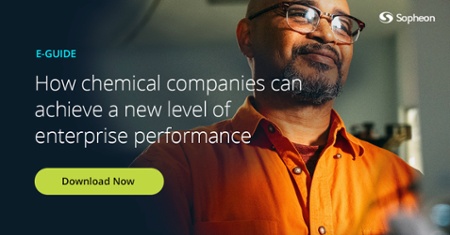Reading time: 7 minutes
Chemical companies often experience disconnects between strategy and operational execution. This results in missed opportunities, loss of market share or even extinction of whole lines of business. (Think Kodak) The quicker companies execute on agreed strategies, the more successful they are.
Chemical companies today encounter headwinds from every direction. Whether it’s a patchwork of regulations from country to country, aggressive startups leveraging the latest technologies, pressures to become more sustainable, or unforeseen supply chain issues, these are challenging times for chemical companies trying to plan for the future. But, when you look at the history of the chemical industry, you discover that the best companies have found solutions to overcome market obstacles. These organizations have excelled at innovation, in large part because of their ability to move quickly from strategy to execution.
Many of Sopheon’s chemical customers started in different industries and transformed their business portfolios into their current leadership roles. For example, a few began in mining, but evolved from those roots into global leaders in the specialty chemicals, materials, and even electronics and high-tech markets. Among some of these organizations' diverse product portfolios today, you will find pharmaceuticals, including chemicals critical to producing COVID vaccines.
When new opportunities emerge, companies must be swift with their innovations, or they won’t be successful. In addition to addressing new market opportunities, innovation is an effective way to improve margins on existing products and services. But the path from vision and strategy to product launch can be rocky. It’s a road filled with detours and distractions. Chemical companies must implement a systematic approach to innovation so that all stakeholders have visibility into the complete innovation lifecycle and the ability to participate when appropriate.
These three important factors will help any chemical company survive and thrive sustainably.
Visibility from strategy through to execution
All companies have portfolio businesses, and these portfolios need to adapt as circumstances— like markets, customers, technologies, and regulations, for example—change. It’s simply not enough to know what products are in a company’s pipeline. There must be proper context for where each product stands in its lifecycle and how it contributes to the success of the business portfolio. Companies must position each product on a prioritized list that meets the organization’s strategic objectives.
Most chemical companies have so many projects on various maturity levels that it’s easy for information to get lost and intermingled. There are small improvement projects, mid-size update projects, and completely new products and services. And, of course, there are the potential breakthrough ideas that each company hopes will be a market mover.
Without a single source of truth that provides all the necessary information in the relevant context, it’s nearly impossible to keep track of everything. Consequently, it’s common for companies to have a skewed notion of where things stand and make decisions based on incorrect data. Or, sometimes worse, they make no decision based on the perceived lack of data or context. These companies lack pipeline transparency.
Here’s a real-world example of how a lack of visibility led a company off its strategic path. Recently, a company we started working with believed that approximately 60% of its innovation budget was directed toward improvements to current products, while the remaining 40% was invested in new product innovation. But when they started using Sopheon’s innovation management system, it became clear the company’s assumptions were incorrect. In fact, this organization realized that more than 90% of its innovation budget was funding incremental improvements to existing products. Very few resources were left for innovation projects that make a company a dynamic, creative market force. With greater visibility into its product pipeline, the company made the necessary adjustments to reallocate resources and get back on the path to a better-balanced innovation portfolio.
Reprioritizing chemical product development
Unpredictability is always challenging for organizations, even more so for chemical companies. One of the most effective strategies to mitigate risk is running various “what if” scenarios. A comprehensive impact portfolio analysis will help a company identify which initiatives are most likely to succeed and whether or not they should reprioritize other projects.
In addition to dealing with the short-term problems of an unpredictable market, many chemical companies find themselves reprioritizing long-term product plans based on sustainability and the move toward a “circular economy.” In a circular economy, companies are extending beyond sustainability and put a premium on reducing waste and repurposing and reusing materials.
In a recent episode of Innovation+ Talks, Paul Heller and I discussed the challenges companies face in building the eco-systems necessary to create circular economies.
Business leaders need to make informed decisions based on accurate and up-to-date data to ensure short-term market success and execute the long-term strategic shifts necessary to create a circular economy. The best way to keep everyone informed on all projects is a single source of truth that connects strategic planning with tactical execution and gives executives the information necessary to make smart product decisions
Chemical innovation demands adaptability
Regardless of the times, adaptability and agility are hallmarks of successful companies. Market needs and demands can change quickly—companies must be agile to keep up. Unfortunately, the larger a chemical company is, the more difficult it is to pivot quickly.
Here’s an example of ingenuity in action. BASF, a chemical company that receives many of its supplies by ship, was experiencing supply chain disruptions. In this case, historically low water levels near a key facility in Europe made it impossible for cargo ships to get in or out of port in a predictable and timely fashion. The organization put its innovation skills to work and teamed with a ship engineering company to build transportation vessels capable of navigating lower-than-usual water levels. That’s adaptability.
In some respects, the stakes are higher than ever. Chemical companies need to adapt in many ways. As noted earlier, nimble startups leveraging the latest technologies are doing creative things in the market. Constantly evolving regulations require constant changes, often from region to region. And, of course, concerns over climate change are driving efforts related to sustainability and the circular economy. Chemical companies have no choice but to face these challenges head-on. Those that adapt and innovate by moving quickly from strategy to execution will succeed, and those that don’t will likely fall by the wayside.
Creating the path from strategy to execution
As is the case with many industries, chemical companies often experience disconnects between strategy and investments on one end and the activities related to operational execution on the other. Innovation processes have traditionally been managed using a combination of Excel-based programs or software tools that manage specific aspects of innovation efforts. Neither home-grown systems nor traditional software tools provide the visibility, efficiency and collaboration support required for successful innovation under today’s circumstances.
- Excel-based programs and project-focused tools do not provide a single source of truth. They only offer a narrow and limited view of the innovation pipeline. Additionally, they fail to leverage industry best practices and do not provide the data quality or history necessary to make critical decisions when time is limited. In a recent Innovation+ Talks episode, Paul Heller and I discussed the problems with homegrown systems and offered advice on migrating toward a better system.
- Most traditional software products that claim to be comprehensive are actually aggregations of loosely integrated, stitched together products. These solutions rarely provide the seamless experience that stakeholders across different functions within chemical companies require.
These approaches tend to be time-intensive, include inconsistent, out-of-date data, and the “handoffs” between departments often result in breakdowns. As a result, the innovation pipeline is cluttered with countless small, invaluable projects. Meanwhile, major strategic initiatives are regularly postponed due to the attention and resources being given to projects of lesser long-term significance.
Given the complexity of their various processes, chemical companies must have a complete picture of their processes from strategy through to execution.
Take a few minutes to listen to this interview with Herman Dikland, CTO at ARLANXEO, one of the world’s largest elastomer and synthetic rubber manufacturers. Herman appeared with Sopheon’s EMEA VP EMEA Pieter Leijten on the Dutch television program "How It’s Done" to discuss how Sopheon collaborates with its blue-chip clients to transform their innovation performance and new product development, from strategy to execution and beyond. Watch How It's Done
Prepare your chemical company to master the challenges of the ever-evolving enterprise and give your chemical company a competitive edge by closing the strategy execution gap. Download this eGuide to see how you can boost the enterprise performance of your chemical business.







